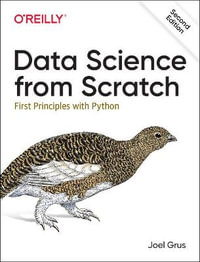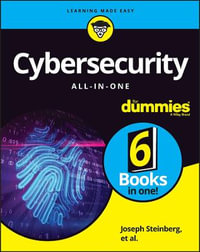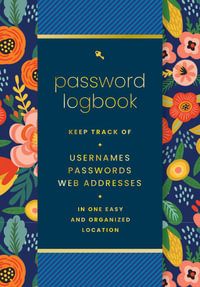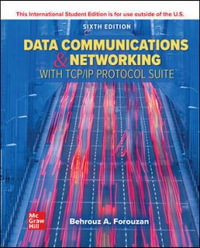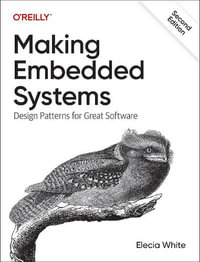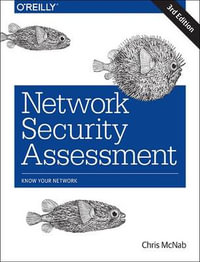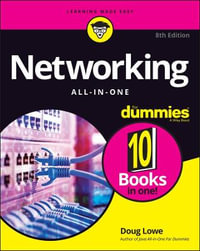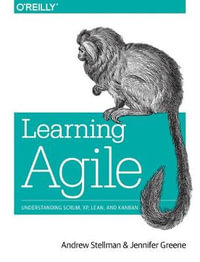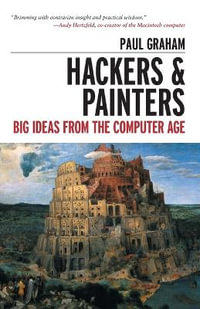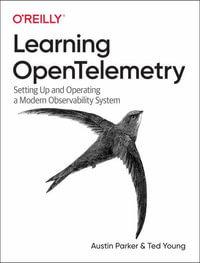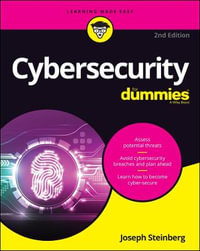
Malware Analyst's Cookbook and DVD
Tools and Techniques for Fighting Malicious Code
By: Michael Ligh, Steven Adair, Blake Hartstein, Matthew Richard
Paperback | 15 October 2010 | Edition Number 1
At a Glance
752 Pages
23.5 x 18.8 x 3.9
Paperback
RRP $99.95
$64.50
35%OFF
or 4 interest-free payments of $16.13 with
orAims to ship in 7 to 10 business days
When will this arrive by?
Enter delivery postcode to estimate
Introduction xv
On The Book’s DVD xxiii
1 Anonymizing Your Activities 1
Recipe 1-1: Anonymous Web Browsing with Tor 3
Recipe 1-2: Wrapping Wget and Network Clients with Torsocks 5
Recipe 1-3: Multi-platform Tor-enabled Downloader in Python 7
Recipe 1-4: Forwarding Traffic through Open Proxies 12
Recipe 1-5: Using SSH Tunnels to Proxy Connections 16
Recipe 1-6: Privacy-enhanced Web browsing with Privoxy 18
Recipe 1-7: Anonymous Surfing with Anonymouse.org 20
Recipe 1-8: Internet Access through Cellular Networks 21
Recipe 1-9: Using VPNs with Anonymizer Universal 23
2 Honeypots 27
Recipe 2-1: Collecting Malware Samples with Nepenthes 29
Recipe 2-2: Real-Time Attack Monitoring with IRC Logging 32
Recipe 2-3: Accepting Nepenthes Submissions over HTTP with Python 34
Recipe 2-4: Collecting Malware Samples with Dionaea 37
Recipe 2-5: Accepting Dionaea Submissions over HTTP with Python 40
Recipe 2-6: Real-time Event Notification and Binary Sharing with XMPP 41
Recipe 2-7: Analyzing and Replaying Attacks Logged by Dionea 43
Recipe 2-8: Passive Identification of Remote Systems with p0f 44
Recipe 2-9: Graphing Dionaea Attack Patterns with SQLite and Gnuplot 46
3 Malware Classification 51
Recipe 3-1: Examining Existing ClamAV Signatures 52
Recipe 3-2: Creating a Custom ClamAV Database 54
Recipe 3-3: Converting ClamAV Signatures to YARA 59
Recipe 3-4: Identifying Packers with YARA and PEiD 61
Recipe 3-5: Detecting Malware Capabilities with YARA 63
Recipe 3-6: File Type Identification and Hashing in Python 68
Recipe 3-7: Writing a Multiple-AV Scanner in Python 70
Recipe 3-8: Detecting Malicious PE Files in Python 75
Recipe 3-9: Finding Similar Malware with ssdeep 79
Recipe 3-10: Detecting Self-modifying Code with ssdeep 82
Recipe 3-11: Comparing Binaries with IDA and BinDiff 83
4 Sandboxes and Multi-AV Scanners 89
Recipe 4-1: Scanning Files with VirusTotal 90
Recipe 4-2: Scanning Files with Jotti 92
Recipe 4-3: Scanning Files with NoVirusThanks 93
Recipe 4-4: Database-Enabled Multi-AV Uploader in Python 96
Recipe 4-5: Analyzing Malware with ThreatExpert 100
Recipe 4-6: Analyzing Malware with CWSandbox 102
Recipe 4-7: Analyzing Malware with Anubis 104
Recipe 4-8: Writing AutoIT Scripts for Joebox 105
Recipe 4-9: Defeating Path-dependent Malware with Joebox 107
Recipe 4-10: Defeating Process-dependent DLLs with Joebox 109
Recipe 4-11: Setting an Active HTTP Proxy with Joebox 111
Recipe 4-12: Scanning for Artifacts with Sandbox Results 112
5 Researching Domains and IP Addresses 119
Recipe 5-1: Researching Domains with WHOIS 120
Recipe 5-2: Resolving DNS Hostnames 125
Recipe 5-3: Obtaining IP WHOIS Records 129
Recipe 5-4: Querying Passive DNS with BFK 132
Recipe 5-5: Checking DNS Records with Robtex 133
Recipe 5-6: Performing a Reverse IP Search with DomainTools 134
Recipe 5-7: Initiating Zone Transfers with dig 135
Recipe 5-8: Brute-forcing Subdomains with dnsmap 137
Recipe 5-9: Mapping IP Addresses to ASNs via Shadowserver 138
Recipe 5-10: Checking IP Reputation with RBLs 140
Recipe 5-11: Detecting Fast Flux with Passive DNS and TTLs 143
Recipe 5-12: Tracking Fast Flux Domains 146
Recipe 5-13: Static Maps with Maxmind, matplotlib, and pygeoip 148
Recipe 5-14: Interactive Maps with Google Charts API 152
6 Documents, Shellcode, and URLs 155
Recipe 6-1: Analyzing JavaScript with Spidermonkey 156
Recipe 6-2: Automatically Decoding JavaScript with Jsunpack 159
Recipe 6-3: Optimizing Jsunpack-n Decodings for Speed and Completeness 162
Recipe 6-4: Triggering exploits by Emulating Browser DOM Elements 163
Recipe 6-5: Extracting JavaScript from PDF Files with pdfpy 168
Recipe 6-6: Triggering Exploits by Faking PDF Software Versions 172
Recipe 6-7: Leveraging Didier Stevens’s PDF Tools 175
Recipe 6-8: Determining which Vulnerabilities a PDF File Exploits 178
Recipe 6-9: Disassembling Shellcode with DiStorm 185
Recipe 6-10: Emulating Shellcode with Libemu 190
Recipe 6-11: Analyzing Microsoft Office Files with OfficeMalScanner 193
Recipe 6-12: Debugging Office Shellcode with DisView and MalHost-setup 200
Recipe 6-13: Extracting HTTP Files from Packet Captures with Jsunpack 204
Recipe 6-14: Graphing URL Relationships with Jsunpack 206
7 Malware Labs 211
Recipe 7-1: Routing TCP/IP Connections in Your Lab 215
Recipe 7-2: Capturing and Analyzing Network Traffic 217
Recipe 7-3: Simulating the Internet with INetSim 221
Recipe 7-4: Manipulating HTTP/HTTPS with Burp Suite 225
Recipe 7-5: Using Joe Stewart’s Truman 228
Recipe 7-6: Preserving Physical Systems with Deep Freeze 229
Recipe 7-7: Cloning and Imaging Disks with FOG 232
Recipe 7-8: Automating FOG Tasks with the MySQL Database 236
8 Automation 239
Recipe 8-1: Automated Malware Analysis with VirtualBox 242
Recipe 8-2: Working with VirtualBox Disk and Memory Images 248
Recipe 8-3: Automated Malware Analysis with VMware 250
Recipe 8-4: Capturing Packets with TShark via Python 254
Recipe 8-5: Collecting Network Logs with INetSim via Python 256
Recipe 8-6: Analyzing Memory Dumps with Volatility 258
Recipe 8-7: Putting all the Sandbox Pieces Together 260
Recipe 8-8: Automated Analysis with ZeroWine and QEMU 271
Recipe 8-9: Automated Analysis with Sandboxie and Buster 276
9 Dynamic Analysis 283
Recipe 9-1: Logging API calls with Process Monitor 286
Recipe 9-2: Change Detection with Regshot 288
Recipe 9-3: Receiving File System Change Notifications 290
Recipe 9-4: Receiving Registry Change Notifications 294
Recipe 9-5: Handle Table Diffing 295
Recipe 9-6: Exploring Code Injection with HandleDiff 300
Recipe 9-7: Watching BankpatchC Disable Windows File Protection 301
Recipe 9-8: Building an API Monitor with Microsoft Detours 304
Recipe 9-9: Following Child Processes with Your API Monitor 311
Recipe 9-10: Capturing Process, Thread, and Image Load Events 314
Recipe 9-11: Preventing Processes from Terminating 321
Recipe 9-12: Preventing Malware from Deleting Files 324
Recipe 9-13: Preventing Drivers from Loading 325
Recipe 9-14: Using the Data Preservation Module 327
Recipe 9-15: Creating a Custom Command Shell with ReactOS 330
10 Malware Forensics 337
Recipe 10-1: Discovering Alternate Data Streams with TSK 337
Recipe 10-2: Detecting Hidden Files and Directories with TSK 341
Recipe 10-3: Finding Hidden Registry Data with Microsoft’s Offline API 349
Recipe 10-4: Bypassing Poison Ivy’s Locked Files 355
Recipe 10-5: Bypassing Conficker’s File System ACL Restrictions 359
Recipe 10-6: Scanning for Rootkits with GMER 363
Recipe 10-7: Detecting HTML Injection by Inspecting IE’s DOM 367
Recipe 10-8: Registry Forensics with RegRipper Plug-ins 377
Recipe 10-9: Detecting Rogue-Installed PKI Certificates 384
Recipe 10-10: Examining Malware that Leaks Data into the Registry 388
11 Debugging Malware 395
Recipe 11-1: Opening and Attaching to Processes 396
Recipe 11-2: Configuring a JIT Debugger for Shellcode Analysis 398
Recipe 11-3: Getting Familiar with the Debugger GUI 400
Recipe 11-4: Exploring Process Memory and Resources 407
Recipe 11-5: Controlling Program Execution 410
Recipe 11-6: Setting and Catching Breakpoints 412
Recipe 11-7: Using Conditional Log Breakpoints 415
Recipe 11-8: Debugging with Python Scripts and PyCommands 418
Recipe 11-9: Detecting Shellcode in Binary Files 421
Recipe 11-10: Investigating Silentbanker’s API Hooks 426
Recipe 11-11: Manipulating Process Memory with WinAppDbg Tools 431
Recipe 11-12: Designing a Python API Monitor with WinAppDbg 433
12 De-Obfuscation 441
Recipe 12-1: Reversing XOR Algorithms in Python 441
Recipe 12-2: Detecting XOR Encoded Data with yaratize 446
Recipe 12-3: Decoding Base64 with Special Alphabets 448
Recipe 12-4: Isolating Encrypted Data in Packet Captures 452
Recipe 12-5: Finding Crypto with SnD Reverser Tool, FindCrypt, and Kanal 454
Recipe 12-6: Porting OpenSSL Symbols with Zynamics BinDiff 456
Recipe 12-7: Decrypting Data in Python with PyCrypto 458
Recipe 12-8: Finding OEP in Packed Malware 461
Recipe 12-9: Dumping Process Memory with LordPE 465
Recipe 12-10: Rebuilding Import Tables with ImpREC 467
Recipe 12-11: Cracking Domain Generation Algorithms 476
Recipe 12-12: Decoding Strings with x86emu and Python 481
13 Working with DLLs 487
Recipe 13-1: Enumerating DLL Exports 488
Recipe 13-2: Executing DLLs with rundll32exe 491
Recipe 13-3: Bypassing Host Process Restrictions 493
Recipe 13-4: Calling DLL Exports Remotely with rundll32ex 495
Recipe 13-5: Debugging DLLs with LOADDLLEXE 499
Recipe 13-6: Catching Breakpoints on DLL Entry Points 501
Recipe 13-7: Executing DLLs as a Windows Service 502
Recipe 13-8: Converting DLLs to Standalone Executables 507
14 Kernel Debugging 511
Recipe 14-1: Local Debugging with LiveKd 513
Recipe 14-2: Enabling the Kernel’s Debug Boot Switch 514
Recipe 14-3: Debug a VMware Workstation Guest (on Windows) 517
Recipe 14-4: Debug a Parallels Guest (on Mac OS X) 519
Recipe 14-5: Introduction to WinDbg Commands And Controls 521
Recipe 14-6: Exploring Processes and Process Contexts 528
Recipe 14-7: Exploring Kernel Memory 534
Recipe 14-8: Catching Breakpoints on Driver Load 540
Recipe 14-9: Unpacking Drivers to OEP 548
Recipe 14-10: Dumping and Rebuilding Drivers 555
Recipe 14-11: Detecting Rootkits with WinDbg Scripts 561
Recipe 14-12: Kernel Debugging with IDA Pro 566
15 Memory Forensics with Volatility 571
Recipe 15-1: Dumping Memory with MoonSols Windows Memory Toolkit 572
Recipe 15-2: Remote, Read-only Memory Acquisition with F-Response 575
Recipe 15-3: Accessing Virtual Machine Memory Files 576
Recipe 15-4: Volatility in a Nutshell 578
Recipe 15-5: Investigating processes in Memory Dumps 581
Recipe 15-6: Detecting DKOM Attacks with psscan 588
Recipe 15-7: Exploring csrssexe’s Alternate Process Listings 591
Recipe 15-8: Recognizing Process Context Tricks 593
16 Memory Forensics: Code Injection and Extraction 601
Recipe 16-1: Hunting Suspicious Loaded DLLs 603
Recipe 16-2: Detecting Unlinked DLLs with ldr_modules 605
Recipe 16-3: Exploring Virtual Address Descriptors (VAD) 610
Recipe 16-4: Translating Page Protections 614
Recipe 16-5: Finding Artifacts in Process Memory 617
Recipe 16-6: Identifying Injected Code with Malfind and YARA 619
Recipe 16-7: Rebuilding Executable Images from Memory 627
Recipe 16-8: Scanning for Imported Functions with impscan 629
Recipe 16-9: Dumping Suspicious Kernel Modules 633
17 Memory Forensics: Rootkits 637
Recipe 17-1: Detecting IAT Hooks 637
Recipe 17-2: Detecting EAT Hooks 639
Recipe 17-3: Detecting Inline API Hooks 641
Recipe 17-4: Detecting Interrupt Descriptor Table (IDT) Hooks 644
Recipe 17-5: Detecting Driver IRP Hooks 646
Recipe 17-6: Detecting SSDT Hooks 650
Recipe 17-7: Automating Damn Near Everything with ssdt_ex 654
Recipe 17-8: Finding Rootkits with Detached Kernel Threads 655
Recipe 17-9: Identifying System-Wide Notification Routines 658
Recipe 17-10: Locating Rogue Service Processes with svcscan 661
Recipe 17-11: Scanning for Mutex Objects with mutantscan 669
18 Memory Forensics: Network and Registry 673
Recipe 18-1: Exploring Socket and Connection Objects 673
Recipe 18-2: Analyzing Network Artifacts Left by Zeus 678
Recipe 18-3: Detecting Attempts to Hide TCP/IP Activity 680
Recipe 18-4: Detecting Raw Sockets and Promiscuous NICs 682
Recipe 18-5: Analyzing Registry Artifacts with Memory Registry Tools 685
Recipe 18-6: Sorting Keys by Last Written Timestamp 689
Recipe 18-7: Using Volatility with RegRipper 692
Index 695
ISBN: 9780470613030
ISBN-10: 0470613033
Published: 15th October 2010
Format: Paperback
Language: English
Number of Pages: 752
Audience: General Adult
Publisher: John Wiley & Sons Inc (US)
Country of Publication: GB
Edition Number: 1
Dimensions (cm): 23.5 x 18.8 x 3.9
Weight (kg): 1.09
Shipping
| Standard Shipping | Express Shipping | |
|---|---|---|
| Metro postcodes: | $9.99 | $14.95 |
| Regional postcodes: | $9.99 | $14.95 |
| Rural postcodes: | $9.99 | $14.95 |
How to return your order
At Booktopia, we offer hassle-free returns in accordance with our returns policy. If you wish to return an item, please get in touch with Booktopia Customer Care.
Additional postage charges may be applicable.
Defective items
If there is a problem with any of the items received for your order then the Booktopia Customer Care team is ready to assist you.
For more info please visit our Help Centre.
You Can Find This Book In

ISC2 CISSP Certified Information Systems Security Professional Official Study Guide & Practice Tests Bundle
Sybex Study Guide
Paperback
RRP $157.95
$97.80
OFF



